Analysis of the charm of soaking extraction--siphon pot brewing complete tutorial (with video)
Professional barista communication, please pay attention to coffee workshop (Weixin Official Accounts cafe_style )
immersion extraction
Immersion extraction method, as the name suggests, its principle is to let coffee powder soak in a container, and hot water for a period of time, dissolution diffusion to smoothly release coffee flavor and aroma substances, and in the impurity precipitation before the completion of extraction. Compared with manual washing, the variation factor of immersion extraction is relatively small. Common immersion extraction apparatus include French press, siphon pot, and philharmonic press. One of the most common appliances is the French press, which is very popular because it is very simple to operate and does not need to add filter paper, which can quickly extract rich coffee.

However, when soaking extraction is used, it does not mean that the filtering steps can be omitted. For example, Philharmonic pressure requires filter paper or metal strainer to filter coffee liquid, while siphon coffee maker is equipped with a filter composed of spring hook, mesh and filter cloth. Filter paper or metal strainer can also be used. With different filters, it will also have an impact on the flavor, such as the coffee made by Philharmonic pressure with filter paper, its flavor is different from the Philharmonic pressure with metal filter. Because the filter paper will absorb oil, the Philharmonic press with metal filter will have a thicker taste, while the siphon pot coffee with metal filter will occasionally produce a metallic taste, the coffee will be made with a sharp taste, and the taste of the ceramic filter is relatively warm and moist, and it is not easy to have residual taste.

The difference between siphon coffee and hand-brewed coffee
Hand-brewed coffee, as the mainstream brewing way of today's boutique coffee, is the love of many "curry fans". Hand-brewed coffee has always been famous for producing coffee with obvious levels of pre-and middle-flavor and aftertaste in just a few steps. By contrast, siphon coffee is so low-key that many people think that siphon coffee is a grandiose version of hand-brewed coffee.

The difference between the two can now be described briefly in the following points:
1. There are differences in filtering
Making hand-brewed coffee requires filter cups, filter papers, small mouth pots and other appliances, while making siphon coffee requires siphon pots, alcohol lamps or light wave ovens and other appliances.
2. There are differences in extraction methods
Hand brewed coffee uses filtration extraction; siphon coffee uses immersion extraction.
3. There are differences in extraction time
The approximate extraction time of hand-brewed coffee will be 2 minutes and 30 to 45 seconds (of course, there are more than 4 minutes of "drip method"); while the extraction time of siphon coffee is at least 2 minutes shorter than that of hand-brewed coffee, usually lasting 50 seconds to 60 seconds.
4. Differences in flavor and taste
Due to the unique extraction method, siphon coffee will taste more fragrant than hand-brewed coffee, which should be related to the filter paper that will filter out part of the oil, if you use filter cloth to hand flush, you can improve the thickness.

Hand rush is unstoppable, and the greatest charm of hand rush is that it can drink a variety of other flavors of coffee, whether sour or firm, rich and multi-layered, and the front, middle and aftertaste are very obvious.
Siphon coffee can best show the original taste, aroma, sour taste, bitter taste, highlighting the taste differences between different individual coffee, the taste is more rich, mellow, mellow.
Siphon is famous for its mellow and thick, and its hands are famous for its elegant, sweet and sour fragrance, each with its own merits.

Working principle of siphon kettle
The main principle of coffee extraction in the siphon pot is realized through the pressure difference. First, the lower cup is heated to boiling, and then inserted into the upper cup, making the lower cup vacuum. Due to the pressure difference between the lower cup and the upper cup, the hot water is mixed with the upper cup coffee powder and extracted. After the extraction process, the fire source of the lower cup is removed, so that the pressure difference between the lower cup and the upper cup is instantly reduced. The gravity between the upper cup and the lower cup will cause the coffee extract to flow back to the lower cup.
Therefore, if you want to speed up the reflux of the coffee extract, you can wipe the lower cup with a wet dishcloth, which can make the pressure difference between the upper and lower cups smaller and the reflux speed faster.

Dosage standard of siphon kettle
one
The standard of adding water to the lower cup of the siphon pot:
The general siphon pot has 2, 3 and 5 people, among which 2 represent 2 cups, each cup standard is 120ml, its maximum capacity is 240 ml, 3 people represent 3 cups, each cup standard is 120ml, its maximum capacity is 360 ml, 5 people represent 5 cups, each cup standard is 120ml, the maximum capacity is 600ml; the scale on the siphon pot represents the capacity, marking a few degrees, then its water capacity is Nfang 120m.
two
Siphon pot coffee powder dosage standard:
Generally speaking, the amount of coffee powder needed to brew a cup of coffee (120ml/ cup) in a siphon pot is about 15g. The coffee powder spoon corresponding to the siphon pot is usually 10g/ spoon, that is, one and a half tablespoons of coffee powder is needed for a cup of coffee; several cups of coffee are added according to the corresponding amount of powder; for example, 3 tablespoons of coffee powder is usually added to make two cups of coffee, that is, 30g coffee powder.
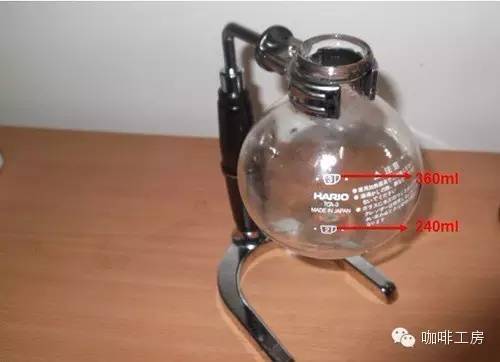
In short:
It takes 15 g coffee powder to make one cup of coffee, 15 g coffee powder to make one cup of coffee, and 30 g coffee powder to brew two cups of coffee. Of course, you can increase or decrease the amount of coffee powder in each cup according to your taste, and generally fluctuate between 10 and 20 g.

The main points of buying siphon pot
At present, siphons on the market can be divided into two categories, domestic, Taiwan, and Japanese, and their prices are also on the increase. There are too many domestic brands not introduced. Taiwan-made brands such as YAMI, Japanese-made more well-known ones are HARIO.
The aspect that needs to pay attention to is the glass material of the siphon pot, which is resistant to high temperature and can accept the difference between high and low temperature. Secondly, according to the different needs, we should pay attention to its capacity. Generally speaking, the siphon pot can be divided into 2 people, 3 people and 5 people. Prices range from 100 to 200 yuan.

Heat source of siphon pot: the general price is the original standard alcohol lamp (left below), and some people will equip themselves with gas stove (right below). The price of alcohol lamp is about 10 to 20 yuan on Taobao, and the price of gas stove is about 80 to 100 yuan.
Alcohol lamp is relatively convenient to buy, drugstores have, the price is cheap, the disadvantage is that it will blacken the bottom of the kettle. (hint: alcohol with high purity should be chosen)
In addition, halogen lamps are now popular in (Tuhao) cafes, also known as light wave ovens, which are heated in a way similar to microwave ovens, which can be heated quickly and steadily, and control the maximum temperature of heating. The only drawback is that it is too expensive.
Of course, there are electric heating, but the efficiency of electric heating.

Mixing rods and filter cloth: stirring rods are generally given away by merchants, and you can buy them separately if you like. Remember to buy bamboo, not other materials.
You'd better buy a lot of filter cloth back (as shown below). The filter cloth is made of thickened cotton cloth, which will turn yellow when it is often used and moldy if it is not properly preserved. You need to change the filter cloth frequently to keep the filter clean. One or two more tablets can be prepared. The general price is 20 yuan, including 10 tablets in a pack.

Other necessary instruments such as thermometers, timers and towels will not be described.
The process of making coffee in a siphon pot
Like many genres of hand-brewed coffee, there are many ways to make coffee in siphon pots, and there is no regulation on how siphon coffee must be operated.
The following coffee brewing process is our own method, does not represent 100% "regular", please "experienced coffee enthusiasts" do not spray, welcome to share your method in the message, and then start the coffee brewing process:
1: heating
First of all, add boiling water to the lower part of the siphon pot, preferably boiled pure water, and then wipe the water droplets on the bottom and surface of the kettle body to avoid cracking when heating.
Cold water is fine, but it takes a long time (especially alcohol lamps).

2: prepare to serve the pot
Put the filter cloth in the upper pot, pull out the small iron hook at the bottom of the filter cloth to catch the pipe mouth, adjust the filter cloth position with a mixing rod, and then put the upper seat on the lower seat, be careful not to insert it vertically, but tilt it.

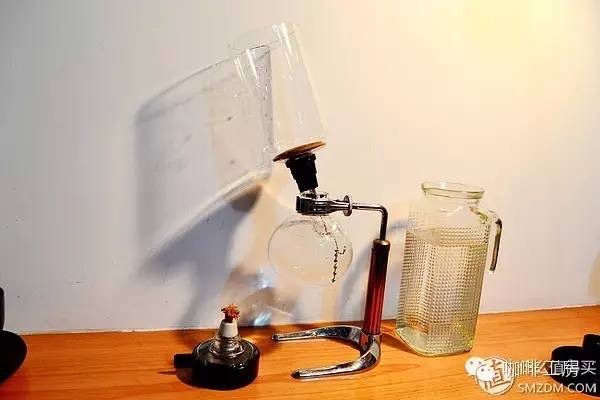
3-1:[Powder first]
Powdering first means putting coffee powder into the pot first and then letting the water flow into the pot.
It is best to first add powder and boil a pot of water in advance to test whether the position of the filter screen is in the middle. If it is not in the middle, it will produce a large number of continuous bubbles.
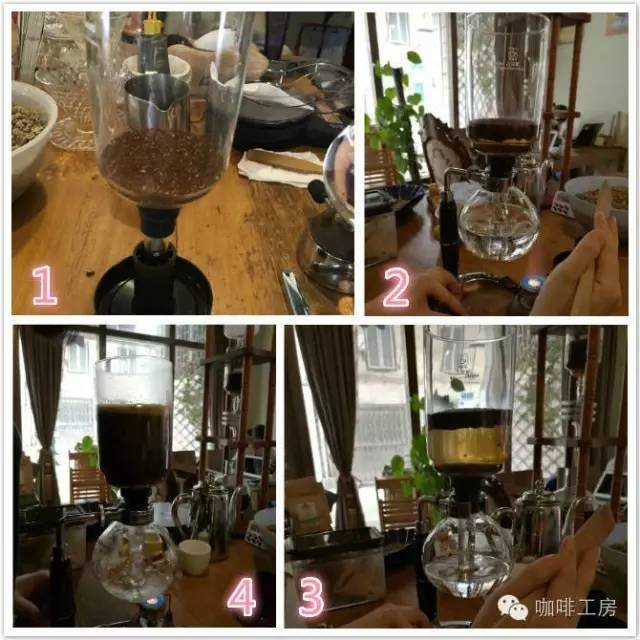
3-2: [after adding powder]
Contrary to adding powder first, adding powder after adding powder is to let the water in the next pot rise completely to the top, and then put in the coffee powder. Before adding powder, we can have plenty of time to reduce the firepower of the fire source just enough to support the water on the pot will not fall back. Then adjust the position of the filter to keep it in the center.
In general, when the water in the lower pot rises to the top, the water temperature will be about 90-95 degrees, so we can let the water temperature drop about 2-5 degrees before putting in the coffee powder. (stirring can accelerate cooling)

4: stir
The coffee powder is then stirred clockwise from the outside to the middle, a process that lasts 10 seconds to ensure that all the coffee powder is immersed in water, and then starts the clock. after 45 seconds (this process is usually called stuffy steaming), the coffee liquid is stirred again with a stirring stick in a clockwise / cross direction for 5 seconds. Turn off the heat after 50-55 seconds, then quickly remove the alcohol lamp and put out the fire until the coffee liquid begins to flow back from the upper cup to the lower cup.

5: siphon reflux
Finally, in the process of coffee liquid reflux, if you wipe the lower cup of the siphon pot with a semi-wet towel, you can quickly reduce the air pressure of the lower pot, thus speeding up the reflux rate of the coffee liquid from the upper cup to the lower cup to avoid over-extraction.
Finally, remove the upper pot, do not pull it out in the vertical direction, so it can not be pulled out, it can be loosened by slight rotation and slight shaking from left to right, so it is easy to take off.
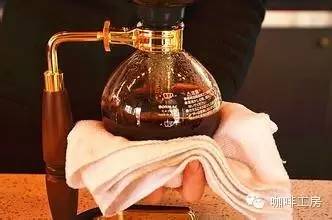
Extraction time of siphon pot
Practical parameters of extraction time:
30 seconds 45 seconds → medium deep baking, deep baked beans
45 seconds 60 seconds → moderate shade, suitable for shallow baking, medium baking, shallow baking
The → concentration, consistency, aroma and bitterness increased for more than 60 seconds, which is suitable for heavy-flavored old cigarettes.
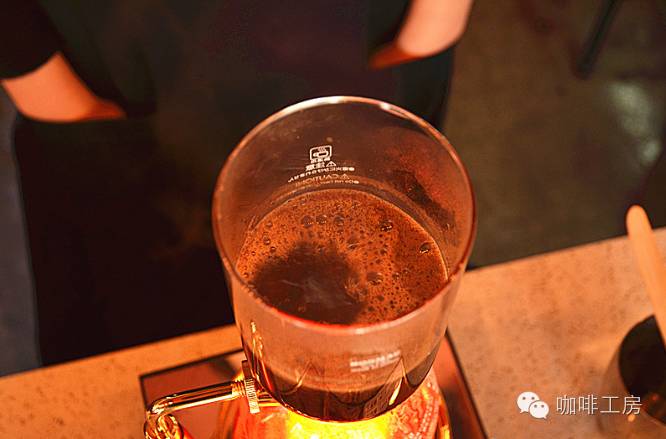
The difference between adding powder first and then adding powder
[adding powder first]
The requirement of firepower control by adding powder first is relatively high, and the firepower should be adjusted to an appropriate size while the water rises, so as not to produce a large number of bubbles to destroy the steaming. The advantage of adding powder first is that there is a gradual warm and wet process for coffee powder, which can reduce the number of circles stirred for the first time, which is more conducive to the formation of steaming effect. However, the temperature control will be poor, so the timing of inserting the upper pot into the next pot will be particularly important, that is to say, it seems simple to add powder first, but in fact, it requires more practical experience than the latter.
[adding powder first] emphasizes high cleanliness, sufficient and persistent aroma, and complete flavor. However, the requirement of proficiency is relatively high, and poor control can easily lead to insufficient extraction or large over-extraction deviation.

[after adding powder]
After adding powder, as long as the firepower of the fire source is lowered just enough to support the water in the upper pot will not fall back, and the temperature of the water cooked by siphon can also be fine-tuned. In general, when the water in the lower pot rises to the upper pot, the water temperature will be about 90-95 degrees, so we can lower the water temperature by about 2-5 degrees before putting in coffee powder. (stirring can accelerate cooling)
Generally speaking, the higher the water temperature, the more bitter and even scorched the coffee will be, while the lower the temperature is, the more obvious the sour taste and aroma will be, but too low will also reduce the alcohol content and make the sour taste very exciting. therefore, it is very important to choose a suitable water temperature for coffee powder according to the extracted coffee.
[after adding powder] the taste is rich, gelatinous and full-bodied, with outstanding middle flavor. Taste cleanliness is relatively weak, aroma is not prominent enough to rise, temperature control is more important.

[the above is the sharing of personal cooking experience]
Details to pay attention to when making coffee in a siphon pot
1. Dry the next bottle, no water droplets.
two。 When you pull out the upper seat, tilt to the right and pull it straight up. Do not break it.
3. The spring under the middle filter should be tightened, the hook should be hooked, and pulled to the center.
4. Plug down tightly when plugging in the seat (but not too hard)
5. Pay attention to water quality: pure water, purified water, magnetized water, do not use mineral water, distilled water
6. The temperature is between 85 and 95 degrees Celsius.
7. Cooking time: full extraction (from water powder contact to filtration) 50: 60 seconds (do not exceed the time too long)
8. Coffee beans should be fresh, coffee beans should be fresh
9. Coffee is best brewed and brewed.
10. Pay attention to the direction of the wind when brewing coffee, do not blow the source of fire directly
11. Pay attention to the size of the fire source: strong fire, large fire, medium fire, small fire, slight fire
twelve。 Beat the boiled coffee powder loosely, pour it out and then rinse the bottle with clean water.
13. The grinding scale is between 2.5 and 3.5. The basic principles are: rough grinding of deep baked beans, fine grinding of shallow baked beans, high scale of the new machine and low scale of the old machine.
14. The coffee cup should be warmed first.
15. The filter should be soaked in clean water or refrigerated to prolong the service life of the filter cloth.
16. When pulling out the upper seat, the focus is on the left hand to hold on to the handle of the lower seat
17. The water in the lower seat had better use hot boiled water, which can save boiling time.
18. The poking method should be correct, not the stirring method.
19. The remaining water in the lower seat had better be poured out, and when the coffee is almost finished, the remaining foam will be separated.
20. When the stick is plucked, just insert 2P3, do not scrape to the bottom filter.
21. Don't touch other moisture in the middle of boiling, then take it back and pull it out.
twenty-two。 Coffee powder and water quantity should be correct.
23. When cooking, cover the upper seat with your hand, smell it with your nose, fan with your hand, and then smell it with your nose.
24. Wipe the lower seat with a wet cloth, wipe the bottom first, and then wipe the left and right sides (to prevent cracking)
25. Coffee beans should be formulated correctly.
twenty-six。 Be sure to wait for the water to boil until it bubbles quickly before you insert it into the upper seat.

The taste of siphon coffee
The taste of siphon coffee will be different in addition to the beans itself. because it is heated by the fire source, it will also produce differences in high, medium and low temperatures with brewing, thus creating rich flavor changes.
The first thing you feel when drinking is hot! Hot! Hot! Then there is sweetness, the sour taste will only come out when the temperature drops slightly; at high temperature, the aroma of coffee is very strong, and when the temperature drops to 70 degrees, the inherent rich taste of coffee beans will gradually emerge.
So, drink siphon coffee must not be too impatient ~ can cool a little bit and then taste it carefully.

[cleaning tips for siphon pots]
1. Hold the glass tube in the upper seat with your hand and gently pat the mouth of the bottle with the palm of your left hand.
two。 Then, tap three more times around the glass to make the coffee powder loose.
3. After the coffee powder is poured out, rinse the inner edge of the cup with clean water and rinse gently around.
4. Then rinse the filter with clean water to remove the dregs.
5. Remove the filter spring hook and rinse thoroughly with clean water.
6. Use both hands to pick up the extrusion circle and wring it dry (please put the filter / cloth ice in the water when not in use to avoid oxidation)
7. Dip the cup brush with detergent, scrub the upper seat, be careful of the bottle mouth breaking, the glass tube hitting the sink or cup, etc.
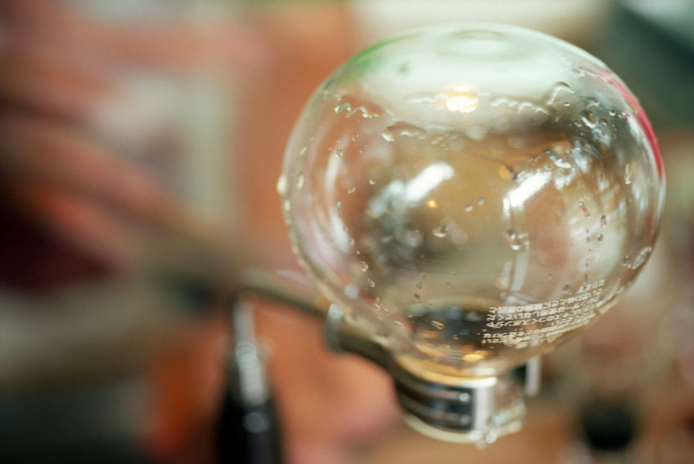
Siphon coffee video appreciation
Finally, we present a perfect interpretation of the whole process of siphon pot brewing coffee by a super handsome guy from Intelligentsia Coffee (intellectual Cafe) in Chicago.
Introduction to classic siphon pot
K NO siphon pot SK-2G
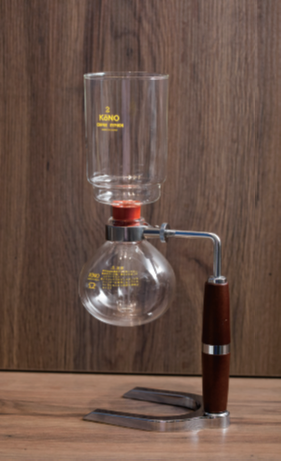
Material: heat-resistant glass, log, stainless steel
In 1923, Kinnono developed the world's first upright siphon pot and established the most common siphon pot style on the market. The glass pot has a thick wall, good thermal insulation and durability, and the most special feature is the design of the arched ceramic filter, which is conducive to drainage. After extraction, the coffee liquid is quickly pulled back to the next pot, which can modify some bad flavors in terms of flavor performance. Create a round and mellow coffee liquid for export, making the coffee more palatable as a whole.
Hario classic siphon coffee maker HTF-2
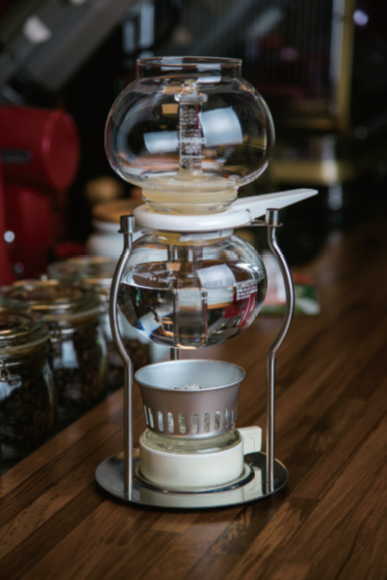
Grindability: medium material: heat resistant glass, stainless steel, PP, aluminum, iron, lead alloy, brass
This siphon pot is an entry-level basic model launched by Hario in the early days. It has been discontinued and needs to be looked for patiently. The characteristic of this siphon kettle is that the shape of its glass adopts the design of imitation antique wind kettle. At present, the style with the same glass shape is MCA-3. However, the early version of the siphon kettle is more retro and rustic in shape, different from the common long tube design.
The revival of glass rods
The use of glass rod filter does not need filter paper or filter cloth, paper and cloth will absorb coffee oil, the oil itself has more aroma, so the use of glass rod filter can retain a more complete coffee flavor.
CONA siphon kettle

Degree of grinding: fine material: glass
CONA is a British coffee utensils brand with a long history, and this siphon pot is also an antique product of early coffee utensils. The most special thing about this siphon pot is that it uses glass rods to filter. Using a siphon pot filtered with a glass rod, the grinding scale can be changed to fine. There is no need for a ceramic filter or a filter cloth. after the extraction is turned off, it can be found that the coffee powder will be surrounded by the glass bar. The coffee liquid is filtered by the coffee powder. The finer the grinding, the cleaner the filtering effect.
CORY siphon kettle
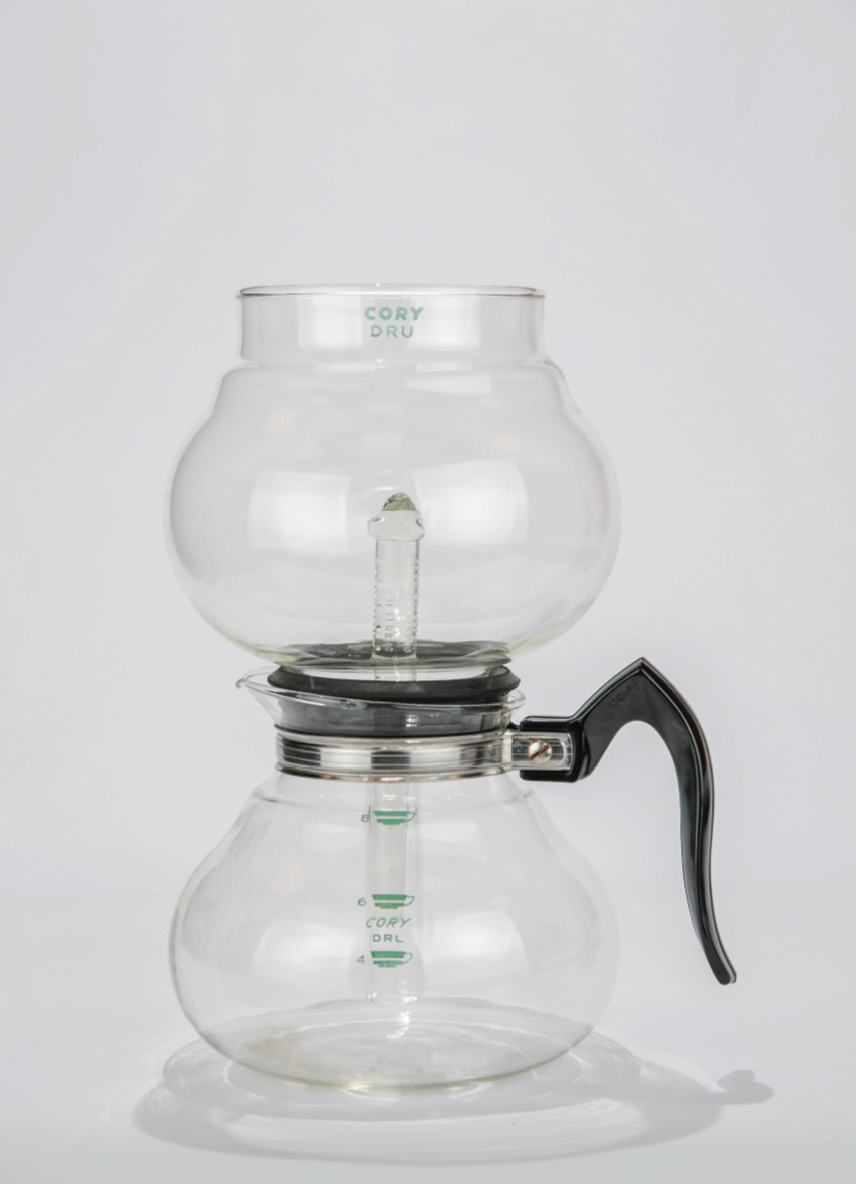
Material: glass
CORY, a coffee utensils brand from the United States, also uses glass sticks to filter its siphon pots. From its pristine and retro appearance, it is estimated that it is about the classic design of the 1930s (in the 1960s, the 1970s was the most popular time for siphon), it can be found that its shape is very large, but because the early coffee pot often takes the positioning of family number and mass extraction, so it has a large capacity.
CONA, Silex glass rods
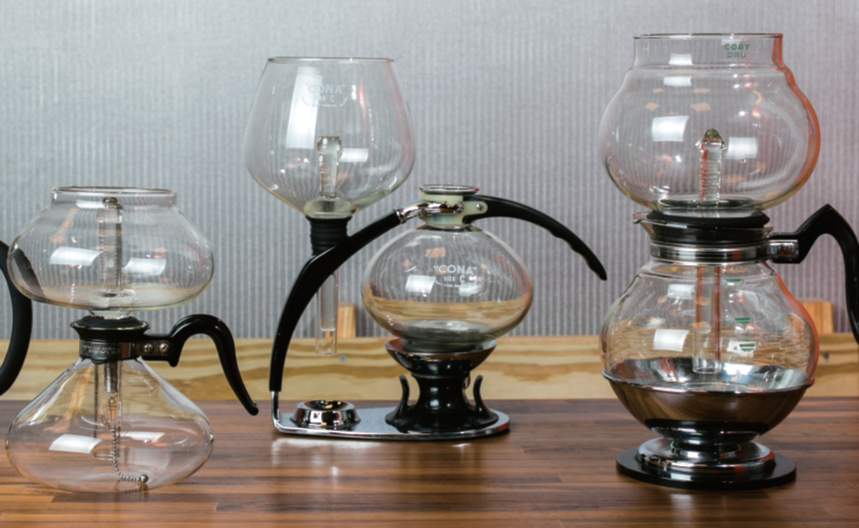
Material: glass
The British Cona glass rod filter is only suitable for the original factory, but the American Cory and Silex glass rod filter can be placed in the modern wind pot. When filter cloth and filter paper became popular, glass filters were left out in the cold, resulting in a fault in the history of siphon pot filters. In modern times, many people did not know that glass rod filters could be used. At present, some stores in China have begun to sell replicated glass rod filters suitable for other brands of wind teapots, in addition to glass materials, there are also ceramic versions.
Important Notice :
前街咖啡 FrontStreet Coffee has moved to new addredd:
FrontStreet Coffee Address: 315,Donghua East Road,GuangZhou
Tel:020 38364473
- Prev

How to bake coffee beans at home? How do you bake coffee in a square cage? How to make coffee after buying raw coffee beans
Coffee lovers not only like the taste of coffee, but also enjoy the fun of making coffee. Then this issue will introduce you to the baking of raw beans and how to bake wonderful coffee beans at home! The history of baking STORYOFROASTED refers to baking raw beans, which must be understood first.
- Next

All kinds of fancy coffee from DIY Starbucks at home? All you need is a cold brew.
What is the best way to spend the summer with coffee lovers? Cold coffee, naturally. Cold brewed coffee tastes far better, smoother and less acidic than brewed hot coffee and chilled in the fridge. But better taste also means longer brewing time and more bean consumption. 2 cups cold brewed coffee, 1 1/2 cups into 1 cup (237ml) ground to medium coffee
Related
- What is the meaning of lactic acid fermentation with coffee bean treatment?
- How to judge the state of foam by sound?
- How does the latte pull out the unicorn pattern? Come to get for a little trick to improve the flower pull!
- Will flower pulling affect the taste of the latte?
- Do you know the history of coffee?
- The difference between honey treatment and sun washing what is raisin honey treatment?
- What kind of milk can a novice use to make coffee foam to keep the foam longer? The correct method and skills of milking tutorial sharing
- Why do washed coffee beans taste sour? Flavor characteristics of washed Coffee
- Introduction to the skill of how to practice the size and height of water injection around the circle of hand-brewed coffee
- How do beginners practice coffee flower drawing from scratch?

